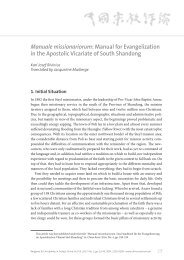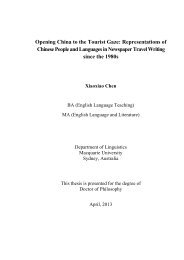EDUCATION IN CHINA
Education-in-China-a-snapshot
Education-in-China-a-snapshot
You also want an ePaper? Increase the reach of your titles
YUMPU automatically turns print PDFs into web optimized ePapers that Google loves.
Chapter 6 – Guangdong<br />
REFORM OF THE HUKOU SYSTEM<br />
FOR MIGRANTS AND THEIR CHILDREN<br />
As the centre of China’s export-led manufacturing<br />
industries, Guangdong is one of the most important<br />
destinations for migrant workers from rural areas all over<br />
China. In 2010, Guangdong province began to experiment<br />
with a point-based system for rural migrant workers to<br />
obtain urban hukou. It is similar to Shanghai’s system,<br />
and since 2010 Guangdong has introduced other new<br />
policies. Starting in 2013, children of migrant workers who<br />
qualify as “highly-skilled” under the pilot programme and<br />
have obtained urban hukou after accumulating sufficient<br />
points can take university entrance exams locally.<br />
Starting 1 January 2014, children whose father or mother<br />
is a migrant worker and who: 1) have a stable job; 2) have<br />
a stable place of residence; 3) have made full social<br />
insurance payments for at least three years; and 4) have<br />
held a Guangdong provincial residential permit for at<br />
least three years, and who themselves have enrolled in a<br />
secondary vocational school for at least three years, may<br />
be eligible to take the entrance exam for post-secondary<br />
vocational schools on equal footing with students holding<br />
Guangdong hukou. The stringent conditions demonstrate<br />
that despite the reforms, children with rural hukou must<br />
surmount significant obstacles in order to take university<br />
entrance exams in their place of residence.<br />
Increasing investment and building partnerships<br />
<strong>IN</strong>CREAS<strong>IN</strong>G <strong>EDUCATION</strong>AL <strong>IN</strong>VESTMENT<br />
Although Guangdong has the highest GDP in China<br />
and invests a huge sum of education, it also has the<br />
largest population. The result of this is that government<br />
appropriated funds for education per school student in<br />
all kinds of education rank below the national average, as<br />
shown in Figure 3.2.<br />
The local government appropriation for education is<br />
very large. It amounts to a figure that is over 19% of<br />
the total government appropriation in recent years,<br />
which is the largest appropriation of any province or<br />
municipality in China. However, because the province’s<br />
population is so large, the educational investment is still<br />
not enough. The gaps in resources and quality between<br />
schools and regions in Guangdong are large compared to<br />
other developed provinces like Jiangsu and Zhejiang.<br />
As required by the State Council in 2011, government<br />
appropriated education funds should continuously<br />
increase. The Guangdong government has set a goal to<br />
increase local government funds for education to over<br />
25% of total local government spending before 2020. The<br />
state government and provincial government charge<br />
companies and individuals between 2% and 3% on the<br />
combined amount of the real-added value tax, consumer<br />
tax and business tax in order to fund education. In addition,<br />
according to this document, 10% of the income from the<br />
sale of land transfers must be used to fund education.<br />
The income generated by these taxes is over and above<br />
the amount earmarked by government appropriated<br />
funds. Some 13% of education funds collected from land<br />
transfer income have been designated for infrastructure<br />
development of rural schools.<br />
COOPERATION WITH HONG KONG<br />
AND MACAU<br />
Sharing the same language and located nearby,<br />
Guangdong has the opportunity to cooperate with<br />
Hong Kong and Macau. The Hong Kong–Zhuhai–Macau<br />
Bridge construction project was begun in 2009. The<br />
project consists of a series of bridges, and tunnels that<br />
will connect Hong Kong, Macau and Zhuhai, three major<br />
regions on the Pearl River Delta in China (Xinhua News<br />
Agency, 2015b). After the project’s completion, which is<br />
due in late 2016, communication between Guangdong,<br />
Hong Kong and Macau will be easier.<br />
A Guangdong free-trade zone was established in April 2015,<br />
and it has played a major role in deepening cooperation<br />
with Hong Kong and Macau. The Guangdong free-trade<br />
zone is also expected to pool educational resources<br />
from Guangdong, Hong Kong and Macau, although it<br />
was originally an economic arrangement. “Introducing<br />
quality educational resources from Hong Kong and Macau<br />
to Guangdong should be an important element in the<br />
cooperation between Guangdong, Hong Kong and Macau,<br />
and it will facilitate the sound development of such<br />
cooperation,” Luo Weiqi, the provincial chief of education in<br />
Guangdong, said in March 2015 (Lulu, 2015). The Shenzhen<br />
campus of the Chinese University of Hong Kong is such an<br />
example as the university benefits students from across the<br />
regions. Meanwhile, the Hengqin campus of the University<br />
of Macau is administered independently by Macau, and<br />
the campus, though located in Zhuhai’s Hengqin district, is<br />
isolated from the rest of Hengqin.<br />
<strong>EDUCATION</strong> <strong>IN</strong> CH<strong>IN</strong>A: A SNAPSHOT © OECD 2016 – 53





